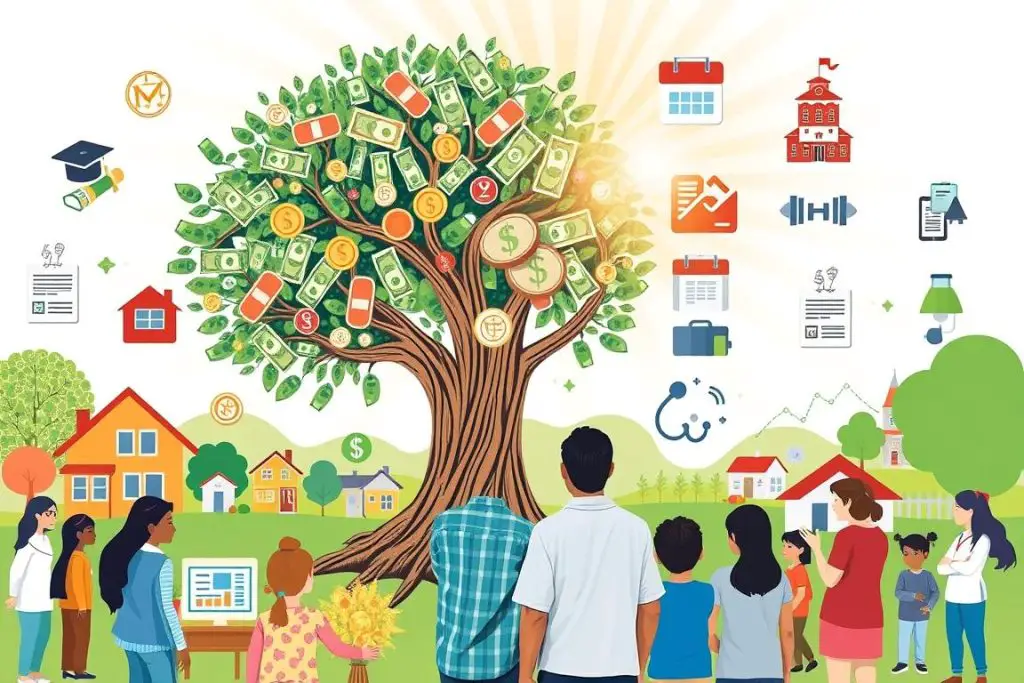Federal Financial Aid: Key Opportunities for Struggling Families You Shouldn’t Miss

Imagine a family finding hope through a federal financial aid program. Suddenly, college for their child shifts from a dream to a real possibility. This story is true for many who uncover federal funding, transforming worry into achieving academic goals. Now, the chance to apply for 2024-2025 assistance begins as early as December, making education more accessible for all1.
The move from Expected Family Contribution to Student Aid Index might help you get a Pell Grant. Don’t miss out on the chance to claim part of the $4 billion in unused aid1. Imagine your family, no matter its size or income, getting up to $7,395 per student each year to support college dreams1. The key step is filling out your FAFSA, a step crucial to your success.
Key Takeaways
- Filing your FAFSA early opens doors to more financial aid prospects1.
- Understand how changes, like the Student Aid Index, impact your aid eligibility1.
- Closing the income division loophole might affect aid for larger families; plan accordingly1.
- Explore all avenues of aid, including federal loans and scholarships, tailored for diverse financial scenarios2.
- For high-income families, 529 plans and private scholarships might be the key to educational funding2.
- Navigating asset considerations is complex but vital in securing maximum aid2.
- Privacy and security are priorities when disclosing personal information for financial aid2.
Understanding the Basics of Federal Financial Aid
Heading into college can feel overwhelming when you think about the costs. Luckily, federal financial aid is here to help make things easier. By learning about and using different types of aid, you can cut down on the stress of paying for college.
Overview of Federal Financial Assistance Programs
Federal financial aid is a game changer for students everywhere. It includes Pell Grants, loans, and work-study programs, helping to ensure money issues don’t stop anyone from getting an education. With costs for public universities around $10,490 a year for locals in 2022-233, looking into federal financial help is key.
Through Federal Student Aid, you can get grants, work-study positions, and loans4. There’s something for everyone, depending on what you need. It’s all about finding the right support for you.
The Importance of Filling Out the FAFSA: Your Gateway to Aid
The FAFSA is your ticket to getting financial help. It’s easier to fill out now, with just 36 questions and takes less than 15 minutes in many cases3. This form isn’t just for federal aid; it’s also your way into state and school aid4. Filling it out can open up a lot of options for funding your education.
Pell Grants: Maximizing Free Aid Opportunities
Pell Grants are awesome for students who really need financial help. You don’t have to pay them back, which is great. For 2024-2025, they might give up to $7,395 to help cover tuition for those who need it most. These grants are key for making college reachable without a lot of loans3.
Yet many Pell Grants go unclaimed because students don’t apply through the FAFSA. This shows why we need to spread the word and encourage more students to apply.
It might seem scary to dive into financial aid, but knowing what’s out there can lead to big rewards. The main thing is to start with the FAFSA. It’s your way into getting Pell Grants, loans, and more, making college a reality without breaking the bank.
Unclaimed Financial Aid: Don’t Leave Money on the Table
Every year, a huge amount of unclaimed federal financial aid is left behind, with over $4 billion in Pell Grants not picked up by eligible grads in 2023 alone5. Many don’t apply due to wrong ideas about who qualifies and the tough steps of the FAFSA.
Picture this: colleges across the U.S. offer aid based on merit, adding up to $46 billion in scholarships every year. Yet, an incredible $100 million in scholarships goes unclaimed yearly because not enough students apply6. Don’t miss out due to myths and confusion about government financial help.
Here’s something to think about: Over 800,000 students who could get FAFSA grants and scholarships didn’t claim them. By not applying, they missed out on an average award of around $4,4777. This isn’t just about lost aid; it’s missing the chance to make college more affordable.
The highest Pell Grant amount was set to $7,395 for the next two academic years, showing significant support that could lower college costs for many5. Don’t ignore these chances – filling out your FAFSA opens up various financial aid options, some of which you might not expect to qualify for.
Taking the step to apply and fill out the FAFSA is key to getting the funds needed for a more affordable college life.
| Financial Aid Type | Potential Amount Unclaimed | Reason for Being Unclaimed |
|---|---|---|
| Pell Grants | $4 billion5 | Misunderstanding of eligibility requirements |
| Scholarships | $100 million6 | Lack of applicants |
| FAFSA Grants | $3.75 billion7 | Failed applications |
Don’t be one of those who miss out on financial aid resources. Whether you’re eyeing Pell Grants, scholarships, or other aids, checking if you’re eligible has no downsides. Start your journey towards securing your educational future. Make sure you claim all the government financial support you’re due.
Federal Financial Assistance Beyond Grants: Exploring Your Options
Federal aid for education goes beyond grants. It includes work-study, loans, and special assistance. These help manage college costs effectively. It’s important to know how these options fit into your plan for school.
The Role of Work-Study Programs in Federal Aid
Work-study programs help you earn money while studying. They can be on or potentially off campus, fitting around your classes. Schools offer these jobs even without Federal Work-Study, aiding in paying for school8
The government treats work-study as part of your aid, offering money and work experience. Earning while learning gives you skills and reduces money worries9
Understanding Federal Loans: Types and Repayment Options
Federal loans come with low interest rates and favorable repayment terms. There are Stafford loans, PLUS loans, and unsubsidized loans. If parents can’t get a PLUS loan, students may get extra unsubsidized loans8
These loans are flexible. They offer options like delayed payment, plans based on your income, and forgiveness for public service workers9
Special Considerations for Foster and Homeless Youth
There are aids for foster and homeless youth. Pell Grants, Chafee Grant, and Cal Grant are some. They support foster youth till age 26 or for five years. The Cal Grant aids those in foster care after age 13 for up to eight years.
Scholarships and programs specifically aid foster and homeless youth. These ensure they have equal chances to succeed in school and life.
Looking into all financial aid options is key. With the right information, you can navigate college funding. This leads to financial relief and progress towards your education.
Conclusion
Federal financial help plays a key role in the U.S., especially for those struggling with money issues. Government aid is really important. It’s proven by real results that lift many Americans. For example, in 2016, California’s nonprofit hospitals spent about 20% of their earnings on helping people financially10. This shows how these programs help people get the services they need.
In 2017, nonprofit hospitals across the country gave out $14.2 billion in aid10. This huge amount shows how important these supports are. They get tax breaks too, which grew from $12.6 billion in 2002 to $24.6 billion in 201110. States like New Jersey and Massachusetts gave a lot too, $319 million10 and $387 million10 respectively. This helps ensure everyone can get medical care.
Finding and understanding federal financial help can be hard, but it’s worth it. By exploring these financial aids, you learn how to get the most help. It’s up to you to use things like Pell Grants and federal loans to lessen the costs of college. By taking action, making smart choices, and knowing what help is out there, you set up a strong future. This future is made better by education and opportunities.
FAQ
What types of federal financial assistance are available for higher education?
Why is completing the FAFSA important?
How much can I receive from a Pell Grant?
What are some reasons why Pell Grants go unclaimed?
Can I work while receiving federal financial aid?
What types of federal loans are available, and how do they differ?
Are there specific financial assistance programs for foster and homeless youth?
If my family has a high income, should I still fill out the FAFSA?
How can I avoid leaving financial aid unclaimed?
Source Links
- Should High-Income Families Fill Out The FAFSA? Experts Weigh In – https://www.forbes.com/sites/robertfarrington/2023/11/29/should-high-income-families-fill-out-the-fafsa-experts-weigh-in/
- Parents | Federal Student Aid – https://financialaidtoolkit.ed.gov/tk/outreach/target/parents.jsp
- Student’s Guide to Financial Aid and the FAFSA | BestColleges – https://www.bestcolleges.com/resources/fafsa/
- Types of Aid and Eligibility | Federal Student Aid – https://financialaidtoolkit.ed.gov/tk/learn/types.jsp
- How Much College Aid Are Students Missing Out On? – Ascent Funding – https://www.ascentfunding.com/blog/how-much-college-aid-are-students-missing-ascent-funding/
- A Guide to Unclaimed Scholarship Money – https://www.sofi.com/learn/content/unclaimed-scholarship-guide/
- Filling Out the FAFSA First Southern National Bank – https://fsnb.net/changes/filling-out-the-fafsa/
- 7 Options if You Didn’t Receive Enough Financial Aid – https://studentaid.gov/articles/financial-aid-not-enough/
- The Different Types of Financial Aid Explained: Loans, Grants, & Work-Study Programs – Ascent Funding – https://www.ascentfunding.com/blog/types-of-financial-aid/
- Understanding Required Financial Assistance in Medical Care | Consumer Financial Protection Bureau – https://www.consumerfinance.gov/data-research/research-reports/understanding-required-financial-assistance-in-medical-care/








